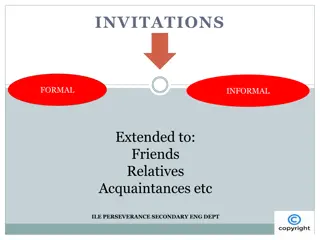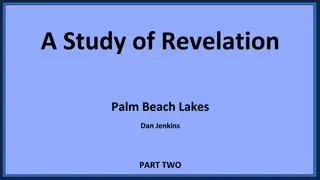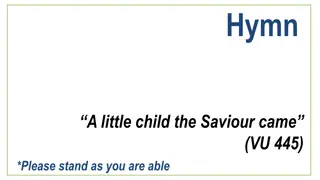
Calling for Discernment: Parables - Understanding Jesus' Teaching Style and Parables
Explore the teaching style of Jesus through parables, learn about the different forms and techniques he used, and understand the purpose and history of interpreting parables. Dive into the enlightening world of Jesus' teachings.
Download Presentation

Please find below an Image/Link to download the presentation.
The content on the website is provided AS IS for your information and personal use only. It may not be sold, licensed, or shared on other websites without obtaining consent from the author. If you encounter any issues during the download, it is possible that the publisher has removed the file from their server.
You are allowed to download the files provided on this website for personal or commercial use, subject to the condition that they are used lawfully. All files are the property of their respective owners.
The content on the website is provided AS IS for your information and personal use only. It may not be sold, licensed, or shared on other websites without obtaining consent from the author.
E N D
Presentation Transcript
Chapter 9 CALLING FOR DISCERNMENT: PARABLES
CHAPTER OUTLINE The Style of Jesus Teaching The Parables of Jesus Guidelines for Interpreting the Parables
THE STYLE OF JESUS TEACHING In order to understand what Jesus taught, it is important to understand how he taught, while at the same time recognizing that the how is simply a medium for the message and not the message itself. Forms and techniques used by Jesus in his teaching: Overstatement Hyperbole Pun Simile Metaphor Riddle Paradox A fortiori statement Irony Questions Parabolic or figurative actions Poetry The most commonly used form, however, is the parable.
THE PARABLES OF JESUS Definition of Parables Long Allegory Short Simile or Metaphor Similitude Short Parable Story parable/ example story Allegorical parable Matt. 13:33 Luke 17:7 10 Mark 12:1 12 Luke 15:11 32
PARABLES OF JESUS Purpose of Parables Parables serve a didactic purpose. They are designed to teach a particular spiritual or moral lesson to a particular audience. Isaiah 6:9 10 At other times, Jesus used parables in order to challenge individuals to respond to his message or to instruct them in some other way (e.g., Matt. 24:32 25:46; Luke 7:40 43; 10). Jesus had a larger purpose in using the parable form. Parables are an encounter mechanism. The parables encounter, interpret and invite the listener/reader to participate in Jesus vision of the kingdom. They are a speech-event ; they grasp our attention and force us to interact with the presence of the kingdom in Jesus, either positively (those around Jesus in Mark 4:10 12) or negatively (those outside ).
HISTORY OF INTERPRETATION OF PARABLES The Early Church Fathers (100 500) During the patristic period,an allegorical method of interpreting Scripture began to emerge. This technique was refined during the time of Origen of Alexandria (A.D. 185 254) who is generally acknowledged to have elevated this approach to a science. The Middle Ages (500 1500) This practice of allegorizing not only continued unabated throughout the Middle Ages, it further intensified. In addition to Origen s threefold sense of Scripture (literal, moral, and spiritual) was added one other element the anagogical. This fourfold sense incorporated the element of the heavenly or eschatological significance of Scripture.
HISTORY OF INTERPRETATION OF PARABLES The Reformation (1500 1800) Martin Luther (1483 1546), a major proponent of the literal and grammatical interpretation of Scripture, strongly opposed the fourfold sense of biblical interpretation. In his opinion, the allegorizers were clerical jugglers performing monkey tricks, and Origen s exegesis worth less than dirt. The Modern Period (1800 present) Adolf J licher. In his two-volume work Die Gleichnisreden Jesu (1888, 1889), he proposed that the parables contained a single picture and taught a single point. From his analysis of parables, he concluded that Jesus neither used allegories nor allegorical traits in his parables and that the presence of such traits was to be attributed to the evangelists. C. H. Dodd, in The Parables of the Kingdom (1935), argued that the parables must be situated within the life and teaching of Jesus, primarily his preaching of the kingdom.
HISTORY OF INTERPRETATION OF PARABLES The Modern Period (1800 present) Rudolf Bultmann, while formulating his laws of transmission, gave impetus to the proposal that simple parables evolved into complex allegories as they were told and retold. Jeremias, in Die Gleichnisse Jesu (1947), building his theory of parable interpretation on the foundations of both J licher and Dodd, also argued that the parables made only one point and that allegorical details were later church. Klyne Snodgrass noted that in this process, the context in the Gospels, such as the introductions, conclusions, and any interpretive comments, were generally considered secondary.
TOWARD A PROPER INTERPRETATION OF PARABLES Most importantly, the parables should be viewed as authentic. In addition, while not falling back on the pattern of extreme allegorization and subjectivity that dominated the interpretation of the church for so long, it is clear that the parables may be more allegorical in character than is generally acknowledged. However, one should allegorize only if the text points to the presence of allegorization by the author. One should not confine a parable to one point if it is evident that more than one truth is being conveyed.
JESUS PARABLES IN THE SYNOPTIC GOSPELS While parables abound in the Synoptic Gospels (especially Matthew and Luke), there are no parables in a more narrow sense in John s Gospel The parables in the Synoptic Gospels are frequently arranged thematically to highlight certain theological emphases.
JEWISH BACKGROUND AND PARALLELS The background of parables is found in the wisdom tradition of Israel (Heb. ma al; Grk. parabol ). Ma al has broad usage encompassing forms as diverse as saying, proverb, wisdom saying, or mocking song. Osborne notes that from its more popular meaning of proverb, it came to be used as a technical term for wisdom teaching until eventually it was taken to encompass a wide range of terms including prophetic proverbs, parables, riddles, and symbolic action.
THE PARABLES OF JESUS Salvation History and the Sitz im Leben Jesu Whereas God is active in all of history in general, his redemptive activity in the history recorded in Scripture is unique. The parables should be interpreted in this light as well. Characteristics of Parables Earthiness Conciseness Major and minor points Repetition
THE PARABLES OF JESUS Characteristics of Parables Conclusion Listener-relatedness Reversal of expectation Kingdom-centered eschatology Kingdom ethics God and salvation
GUIDELINES FOR INTERPRETING PARABLES Determine the structure of the parable. Determine the literary context of the parable. Establish the historical context in order to understand the earthy detail. Make careful note of the points of reference, that is, those items with which the hearer is to identify, and the climax of the narrative. Determine the main point of the parable as well as any secondary points. Determine the original intent of the parable. 1. 2. 3. 4. 5. 6.
GUIDELINES FOR INTERPRETING PARABLES Keep in mind that the entire interpretive process should be based on sound exegetical procedures. Draw all your findings together and summarize the meaning of your parable. Apply the central truth(s) of this parable to the contemporary situation. 7. 8. 9.






















